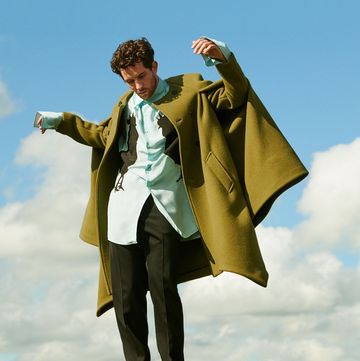The rooms on the northeast corner of the Ambos Mundos hotel in Havana look out, to the north, over the old cathedral, the entrance to the harbor, and the sea, and to the east to Casablanca peninsula, the roofs of all houses in between and the width of the harbor. If you sleep with your feet toward the east, this may be against the tenets of certain religions, the sun, coming up over the Casablanca side and into your open window, will shine on your face and wake you no matter where you were the night before. If you do not choose to get up you can turn around the other way in the bed or roll over. That will not help for long because the sun will be getting stronger and the only thing to do is close the shutter.
Getting up to close the shutter you look across the harbor to the flag on the fortress and see it is straightened out toward you. You look out the north window past the Morro and see that the smooth morning sheen is rippling over and you know the trade wind is coming up early. You take a shower, pull on an old pair of khaki pants and a shirt, take the pair of moccasins that are dry, put the other pair in the window so they will be dry next night, walk to the elevator, ride down, get a paper at the desk, walk across the corner to the cafe and have breakfast.
There are two opposing schools about breakfast. If you knew you were not going to be into fish for two or three hours, a good big breakfast would be the thing. Maybe it is a good thing anyway but I do not want to trust it, so drink a glass of vichy, a glass of cold milk and eat a piece of Cuban bread, read the papers and walk down to the boat. I have hooked them on a full stomach in that sun and I do not want to hook any more of them that way.
We have an ice-box that runs across the stern of the boat with bait iced down on one side and beer and fruit iced on the other. The best bait for big marlin is fresh cero mackerel or kingfish of a pound to three pounds weight. The best beer is Hatuey, the best fruits, in season, are Filipino mangoes, iced pineapple, and alligator pears. Ordinarily we eat the alligator pears for lunch with a sandwich, fixing them with pepper and salt and a freshly squeezed lime. When we run into the beach to anchor, swim and cook a hot lunch on days when fish are not running you can make a French dressing for the pears, adding a little mustard. You can get enough fine, big avocados to feed five people for fifteen cents.
The boat is the Anita, thirty-four feet long, very able in a sea, with plenty of speed for these fish, owned and skippered by Capt. Joe Russell of Key West who brought the first load of liquor that ever came into that place from Cuba and who knows more about swordfish than most Keywesters do about grunts. The other man on board is the best marlin and swordfisherman around Cuba, Carlos Gutierrez, of Zapata, 31, Havana, 54 years old, who goes Captain on a fishing smack in the winter and fishes marlin commercially in the summer. I met him six years ago in Dry Tortugas and first heard about the big marlin that run off Cuba from him. He can, literally, gaff a dolphin through the head back-handed and he has studied the habits of the marlin since he first went fishing for them as a boy of twelve with his father.
As the boat leaves the San Francisco wharf, tarpon are rolling in the slip. Going out of the harbor you see more of them rolling near the live fish cars that are buoyed alongside the line of anchored fishing smacks. Off the Morro in the entrance to the harbor there is a good coral bottom with about twenty fathoms of water and you pass many small boats bottom fishing for mutton fish and red snappers and jigging for mackerel and occasional kingfish. Outside the breeze freshens and as far as you can see the small boats of the marlin fishermen are scattered. They are fishing with four to six heavy handlines in from forty to seventy fathoms drifting for the fish that are travelling deep. We troll for the ones that are on the surface feeding, or travelling, or cruising fifteen or twenty fathoms down. They see the two big teasers or the baits and come up with a smash, usually going head and shoulders out of water on the strike.
Marlin travel from east to west against the current of the gulf stream. No one has ever seen them working in the other direction, although the current of the gulf stream is not so stable; sometimes, just before the new moon, being quite slack and at others running strongly to the westward. But the prevailing wind is the northeast trade and when this blows the marlin come to the top and cruise with the wind, the scythe tail, a light, steely, lavender, cutting the swells as it projects and goes under; the big fish, yellow looking in the water, swimming two or three feet under the surface, the huge pectoral fins tucked close to the flanks, the dorsal fin down, the fish looking a round, fast-moving log in the water except for the erect curve of that slicing tail.
The heavier the current runs to the eastward the more marlin there are; travelling along the edge of the dark, swirling current from a quarter of a mile to four miles off shore; all going in the same direction like cars along a highway. We have been fighting a fish, on days when they were running well, and seen six others pass close to the boat during a space of half an hour.
As an indication of how plentiful they are, the official report from the Havana markets from the middle of March to the 18th of July of this year showed eleven thousand small marlin and one hundred and fifty large marlin were brought into the market by the commercial fishermen of Santa Cruz del Norte, Jaruco, Guanabo, Cojimar, Habana, Chorrera, Marianao, Jaimanitas, Baracoa, Banes, Mariel and Cabanas. Marlin are caught at Matanzas and Cardenas to the east and at Bahia Honda to the west of the towns mentioned but those fish are not shipped to Havana. The big fish had only been running two weeks when this report was compiled.
Fishing with rod and reel from the middle of April through the 18th of July of this season we caught fifty-two marlin and two sailfish. The largest black marlin was 468 pounds, and 12 feet 8 inches long. The largest striped marlin was 343 pounds and 10 feet five inches. The biggest white marlin weighed 87 pounds and was 7 feet 8 inches in length.
The white marlin run first in April and May, then come the immature striped marlin with brilliant stripes which fade after the fish dies. These are most plentiful in May and run into June. Then come the black and striped marlin together. The biggest run of striped marlin is in July and as they get scarce the very big black marlin come through until into September and later. Just before the striped marlin are due to run the smaller marlin drop off altogether and it seems, except for an occasional school of small tuna and bonito, as though the gulf stream were empty. There are so many color variations, some of them caused by feed, others by age, others by the depth of water, in these marlin that anyone seeking notoriety for himself by naming new species could have a field day along the north Cuba coast. For me they are all color and sexual variations of the same fish. This is too complicated a theory to go into a letter.
The marlin hit a trolled bait in four different ways. First, with hunger, again with anger, then simply playfully, last with indifference. Anyone can hook a hungry fish who gives him enough line, doesn't backlash and sets the hook hard enough. What happens then is something else. The main thing is to loosen your drag quickly enough when he starts to jump and make his run, and get the boat after him as he heads out to sea. The hungry marlin smashes at the bait with bill, shoulders, top fin and tail out. If he gets one bait he will turn and charge the other. If you pull the bait out of his mouth he will come for it again as long as there is any bait on the hook.
The angry fish puzzled us for a long time. He would come from below and hit the bait with a smash like a bomb exploding in the water. But as you slacked line to him he had dropped it. Screw down on the drag and race the bait in and he would slam it again without taking it. There is no way to hook a fish acting that way except to strike hard as he smashes. Put the drag on, speed up the boat and sock him as he crashes it. He slams the bait to kill it as long as it seems to be alive.
The playful marlin, probably one who has fed well, will come behind a bait with his fin high, shove his bill clear out of water and take the bait lightly between his bill and pointed lower jaw. When you turn it loose to him he drops it. I am speaking of absolutely fresh bait caught that same day; if the bait were stale you might expect them all to refuse it once they had tasted it. This sort of fish can often be made to hit by speeding the boat up and skipping the bait over the top of the water with the rod. If he does take it, do not give him too much line before you hit him.
The indifferent fish will follow the boat for as many as three or four miles. Looking the baits over, sheering away, coming back to swim deep down below them and follow, indifferent to the bait, yet curious. If such a fish swims with his pectoral fins tucked close to his sides he will not bite. He is cruising and you are on his course. That is all. The minute a marlin sees the bait, if he is going to strike, he raises his dorsal fin and spreads those wide, bright blue pectorals so that he looks like some great, under-sea bird in the water as he follows.
The black marlin is a stupid fish. He is immensely powerful, can jump wonderfully and will break your back sounding but he has not the stamina of the striped marlin, nor his intelligence. I believe they are mostly old, female fish, past their prime and that it is age that gives them that black color. When they are younger they are much bluer and the meat, too, is whiter. If you fight them fast, never letting up, never resting, you can kill them quicker than you could ever kill a striped marlin of the same size. Their great strength makes them very dangerous for the first forty minutes. I mean dangerous to the tackle; no fish is dangerous to a man in a launch. But if you can take what they have to give during that time and keep working on them they will tire much quicker than any striped marlin. The 468 pounder was hooked in the roof of the mouth, was in no way tangled in the leader, jumped eight times completely clear, towed the boat stern first when held tight, sounded four times, but was brought to gaff at the top of the water, fin and tail out, in sixty-five minutes. But if I had not lost a much larger striped marlin the day before after two hours and twenty minutes, and fought a black one the day before for forty-five I would not have been in shape to work him so hard.
Fishing in a five-mile-an-hour current, where a hooked fish will always swim against the current, where the water is from four hundred to seven hundred fathoms deep, there is much to learn about tactics in fighting big fish. But one myth that can be dissipated is the old one that the water pressure at one thousand feet will kill the fish. A marlin dies at the bottom only if he has been hooked in the belly. These fish are used to going to the bottom. They often feed there. They are not built like bottom fish which live always at the same depth but are built to be able to go up and down in any depth. I have had a marlin sound four hundred yards straight down, all the rod under water over the side, bent double with that weight going down, down, down, watching the line go, putting on all pressure possible on the reel to check him, him going down and down until you are sure every inch of line will go. Suddenly he stops sounding and you straighten up, get onto your feet, get the butt in the socket and work him up slowly, finally you have the double line on the reel and think he is coming to gaff and then the line begins to rip out as he hooks up and heads off to sea just under the surface to come out in ten long, clean jumps. This after an hour and a half of fight. Then to sound again. They are a fish all right. The 343 pounder jumped 44 times.
You can fish for them in Cuba from April all through the summer. Big ones will be accidental until the middle of June and we only saw four broadbill all season. But in July and August it is even money any day you go out that you will hook into a fish from three hundred pounds up. Up means a very long way up. The biggest marlin ever brought into the market by the commercial fishermen weighed eleven hundred and seventy-five pounds with head cut off, gutted, tail cut off and flanks cut away; eleven hundred and seventy-five pounds when on the slab, nothing but the saleable meat ready to be cut into steaks. All right. You tell me. What did he weigh in the water and what did he look like when he jumped?
This is the first of a series of letters by Ernest Hemingway. The next one will be from Spain.
















